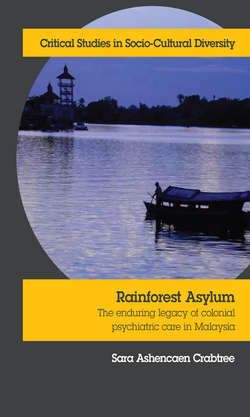Оглавление
Sara Ashencaen Crabtree. Rainforest Asylum
A Rainforest Asylum
Contents
Preface
Acknowledgements
1. Introduction
A guide to terms and semantics
The social and historical background to the study
Organisation and navigation
2. Fieldwork and field relationships
The research process
Gatekeepers and participants
Field notes. Male Ward 1:
Field notes. Female Ward 2:
Planning the research campaign
Language and meaning
Ethics and fieldwork
3. Psychiatry and the colonial enterprise in historical Malaya and Borneo. The historical context in Europe
Complicit psychiatry
Colonial psychiatry and anthropology
Madness and gender in multicultural Malaya
Borneo: Disease, disasters, colonial rule and colonial medicine
The demise of the ‘therapeutic’ asylum in pre and post-war Malaya
Notes
4. The transformation to patient-hood
Categorising patients: The ‘salvageable’ and the ‘irredeemable’
Field notes: Female Ward 2
Field notes: Male Ward 3
The cycle of patient-hood through admission and discharge
Field notes: Female Ward 1
Ward life and the process of socialisation
Field notes: Male Ward 1
Field Notes: Female Ward 1
Field notes: Female Ward 1
Note
5. Ward relationships: Power and reciprocation
Reciprocal relationships
Field notes. Male Ward 1
Dominant relationships
Field notes. Female Ward 2
Field notes. Male Ward 1
Familial relationships and patient labour
Field notes. Female Ward 2
Note
6. Healing, medication and resistance
Field notes. Female Ward 1
Field notes. Male Ward 1
Healing and spirituality
ECT as an instrument of control
Field notes. Female Ward 1
Field notes. Male Ward 1
7. Mad, wanton women and the feminine ideal
‘Open’ and closed wards
Field notes. Locked section, Male Ward 1
Field notes. Female Ward 1
Field notes. Female Ward 1
Gender and recreation
Field notes. Female Ward 2
The lesbian alternative
8. Strategies of containment on the ward
Moral containment of patients and ethnic typecasting
Physical containment of the debased
Fear of the oppressed: Staff accounts of the locked wards
Cunning and deceit: The essentialised patient
Violence towards female staff
9. Towards community psychiatry
Dissent in the ranks
Community psychiatry and coal-face staff
Field notes. Male Ward 1
Field notes. Male Ward 2
Making a difference? Social work and counselling
The views of medical officers
10. Reflections and conclusions
The enduring nature of the asylum
References
Index
Отрывок из книги
A Rainforest Asylum:
The enduring legacy of colonial psychiatric care in Malaysia
.....
Contact with staff provided a fascinating contrast, in that, as stated, while female nursing staff were often reticent, their male counterparts - the ‘medical assistants’ - on the male wards were much more willing to disclose information to me than the female nursing staff and could be, when they chose to be, cheerful, amusing and friendly in their interactions with me. Such was the peculiar and intriguing balance in that in general women patients and male nursing staff were by far the most helpful and friendly towards me, whilst male patients and female nursing staff were often distant, close-lipped and occasionally overtly suspicious of me. As others have noted, women as researchers are seen as more harmless (and usually less socially important) than male researchers by male participants and therefore as less likely to use information in a damaging way (Gurney, 1991; Warren, 1988).
Any perceived lack of status on the grounds of gender may therefore have worked against forming a good rapport with female staff, in that there were few incentives for them to overcome the insider/outsider power dichotomy in an environment of closed ranks. Furthermore, Taylor (1991) points out that in his own research in a male-dominated setting rapport with informants was built upon a foundation of male solidarity, socialising activities and initiation ceremonies, something from which I was culturally barred in my own research with men and which did not materialise with women members of staff. Yet a few friendships were developed between myself and female members of staff, where one nurse occasionally pressed on me bottles of homemade tuak (rice wine), which at first I thought I was expected to pay for and only later realised were spontaneous gifts.
.....
